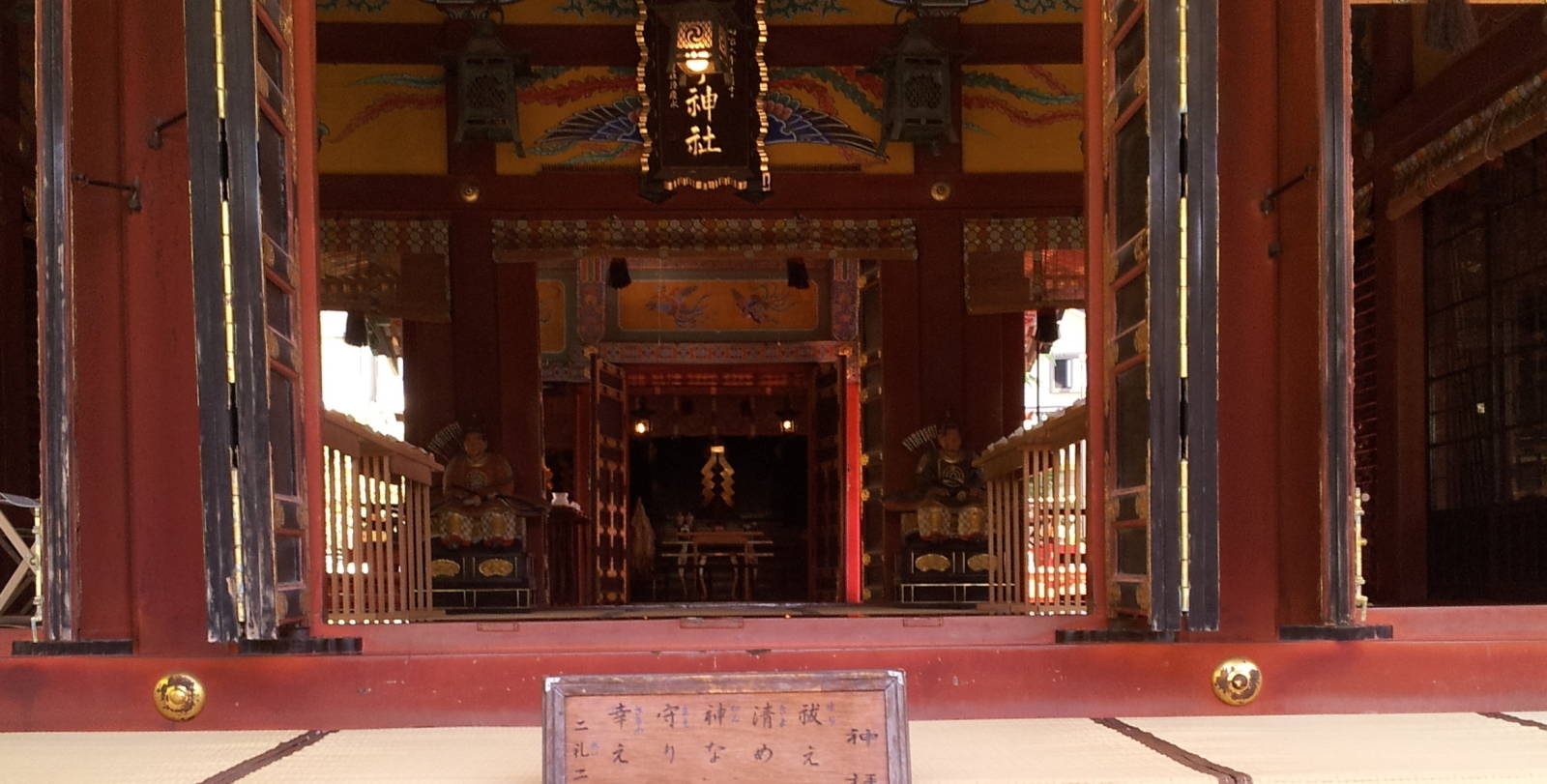
Asakusa Shrine
Asakusa Shrine
Asakusa-jinja or the Asakusa Shrine is one of the most famous and significant Shintō shrines in Tōkyō. Shintō shrines can be quite mysterious to the visitor, as they often enshrine rather ill-defined local spirits. But this one very straightforwardly honors the three men responsible for the large Sensō-ji, the Buddhist temple that is now the most-visited religious site in Japan. In the below picture we're looking through the large torii, a traditional gate marking a passage into a more sacred space at a Shintō shrine.

The Enshrined Heros
Two brothers, Hinokuma Hamanari and Hinokuma Takenari, were fishing in the Sumida River one day in 628 CE. This was long before the city of Tōkyō, there were only small villages in the area. They brought up their nets and found a golden statue of the bodhisattva Kannon. They tried to get rid of it, but it kept coming back. So, they took it back to their village, which now is the site of the Sensō-ji temple complex. Hajino Nakamoto, the chief of the village, recognized it as a holy statue.
Shintō andBuddhism
in Japan
This was very early in the development of Buddhism in Japan. But Hajino Nakamoto, the chief of their village, was Buddhist.
Buddhism at that point wasn't for the masses. Educated priests stayed within monasteries and temples, praying for the Imperial House and the nation. Uneducated and unordained "people's priests" ministered to the common people. They practiced a combination of Daoist and Buddhist philosophy plus some local elements of shamanism. Hajino probably was one of those.
The story says that he delivered an impassioned sermon about the Buddha to the brothers, who immediately converted to Buddhism. He remodeled his home into a temple and enshrined the statue there, so the villagers could worship Kannon. The legend spread, and pilgrims began arriving from all over Japan.
The shrine's symbol is three nets — the three men and the nets in which the statue appeared. Welcome to the confusing mix of religions in Japan, as the statue is of a Buddhist deity, but its discoverers and the Buddhist temple's founder are honored in a Shintō shrine. Actually, the terminology is that their spirits are enshrined here.
Preparing For a Visit
A pair of komainu or lion-dogs guard the approach to the inner shrine. As usual, the protector on your left has an open mouth, pronouncing the sound of the Sanskrit letter अ or A, while the protector on the right has a closed mouth, pronouncing the sound of the Sanskrit latter म or MA. Together they pronounce the sacred syllable Aum or ॐ. Just past the one on the left is the sheltered hand-washing basin.
Aum is a sacred sound of Hinduism. But it is used as a mantra in Buddhist, Jain, and Sikh practice.
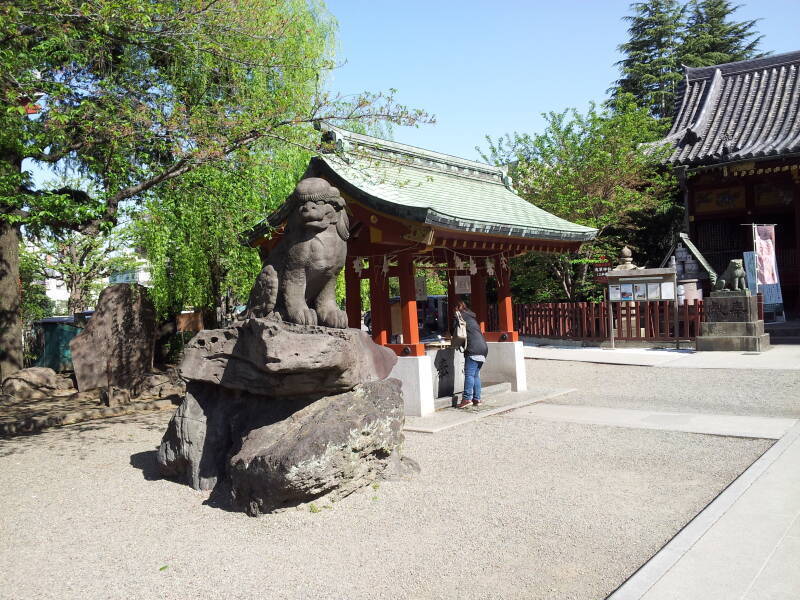
Shintō and Buddhism use the same cleansing water rite, but with different specific names. In Shintō the purification rite is temizu, the water reservoir is chōzubachi, and the shelter is chōzuya or temizuya.
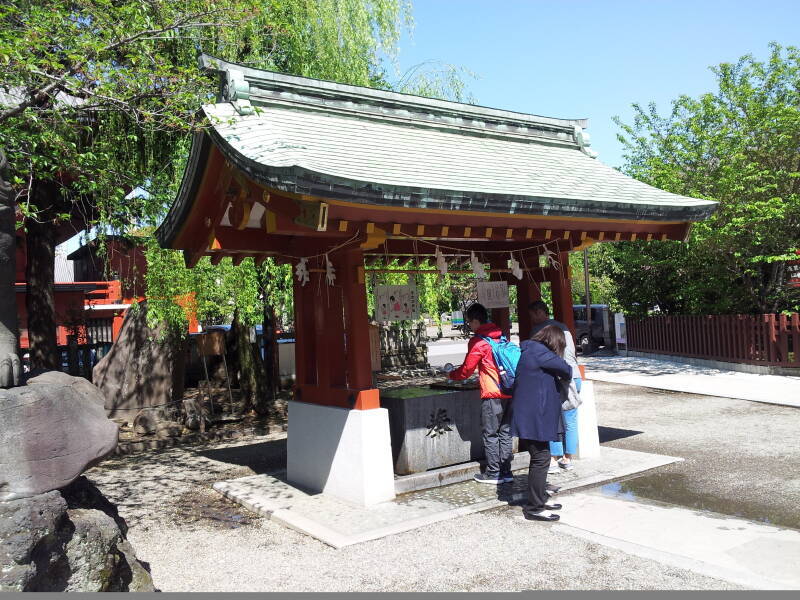
To do this properly:
- Pick up the dipper with your right hand, filling it from where water is pouring in or dipping water out of the reservoir.
- Pour the water over the fingers of your left hand, being careful to make sure that the water falls into the gutter around the reservoir.
- Transfer the dipper to your left hand, get more water if you need it, and pour water over the fingers of your right hand.
- Transfer the dipper back to your right hand, again getting more water as needed, and pour water into your cupped left hand.
- Take water out of your cupped left hand into your mouth, swish it around, then spit it into the gutter around the reservoir.
- Raise the dipper up so that the remaining water runs down over the handle and your right hand, falling into the gutter, and return the dipper to the fountain.
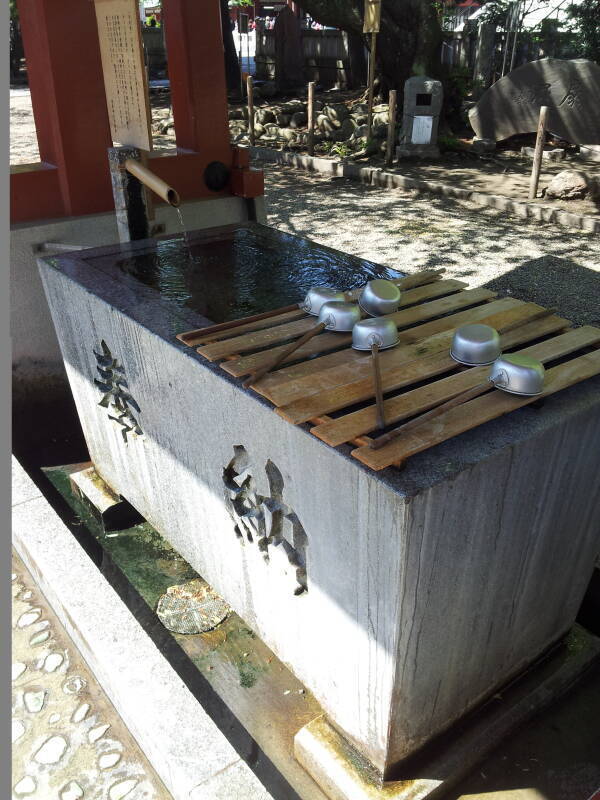
The Inner Shrine
The honden or shinden or shōden is the most sacred structure at a Shintō shrine. It is strictly for the use of the enshrined kami (or spirit), which is usually symbolized by a mirror, or sometimes by a statue. Compare this to the hondō, the main hall at a Buddhist temple.
The honden of a shrine is usually at the rear, inaccessible by the general public. In front of the honden is usually the haiden or oratory. In a more elaborate shrine, a heiden or hall of offerings may connect the haiden to the honden.
Got that? Haiden — heiden — honden from outside to inside.
A fence called tamagaki blocks public access. So in the below picture, we're looking over the offering box and two tamagaki through the haiden to the honden.
The honden is relatively small, typically with a gabled roof. Its doors are kept closed most of the time. At a religious festival, the priests carry out a rite to open the doors then enter the honden briefly to perform rituals. The go-shintai, literally "the sacred body of the kami", is kept in the honden. Except... the go-shintai isn't divine, it's a temporary repository of the enshrined kami.
The third Shōgun Iemitsu Tokugawa built this main building of the Asakusa Shrine in 1649. Unlike most of the Sensō-ji complex, it has escaped the periodic fires and even the destruction of World War II. It survives as a rare example of the gongen-zukuri architectural style that was popular in the Edo era.

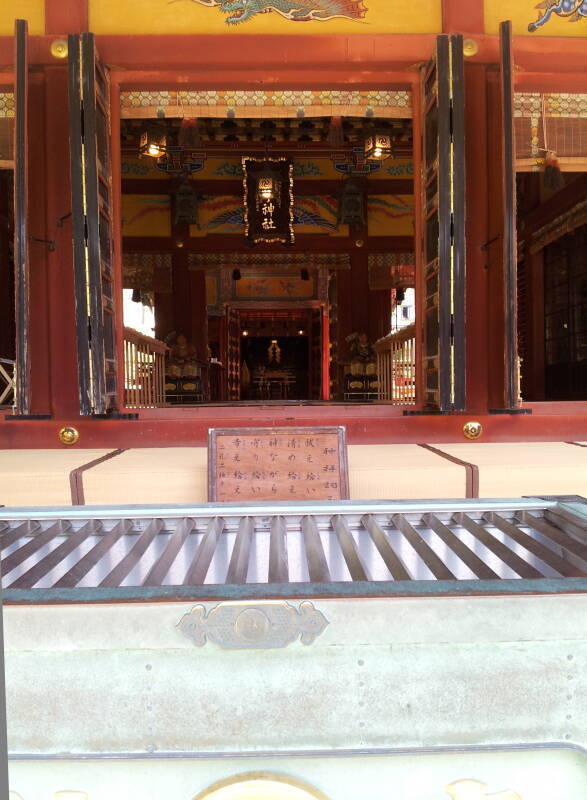
Palanquins or portable shrines called mikoshi carry the shintai, the "god-body", the central totemic object normally kept in the most sacred area of a shrine. Or, to use the honorifics, the o-mikoshi or divine palanquin carries the go-shintai or sacred god-body.
The shintai are not themselves part of the kami or spirit of the shrine. They are temporary repositories which make the kami accessible to human beings for worship. They are also yorishiro, objects that are capable of attracting and, in some sense, capturing kami so they can be "enshrined" or housed within the shrine.
The omikoshi are used to carry the goshintai on a tour of the community at a matsuri or religious festival, or to move it to a new shrine location, or to capture a kami somewhere and transport it to be enshrined at a newly built facility. The omikoshi physically protects the goshintai and hides it from sight.
Here are the three o-mikoshi at the Asakusa Shrine. At the Sanja-matsuri festival these three are joined by another 120 portable shrines of 44 parishoner associations affiliated with Asakusa Shrine.

And Further Shrines
Continue around to the right of the main haiden-honden structure of the shrine, past the o-mikoshi garage, and you pass through another torii into even more exclusively sacred space.
And then multiple additional torii, and further honden.
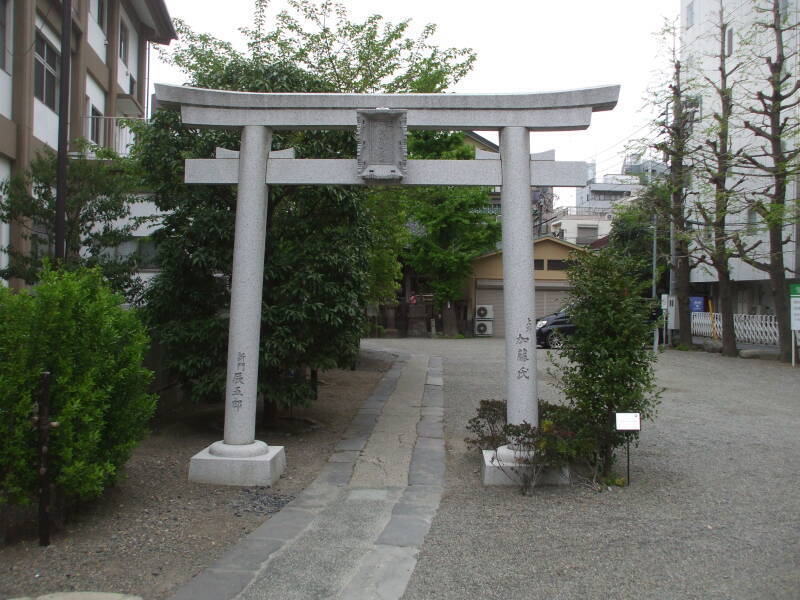
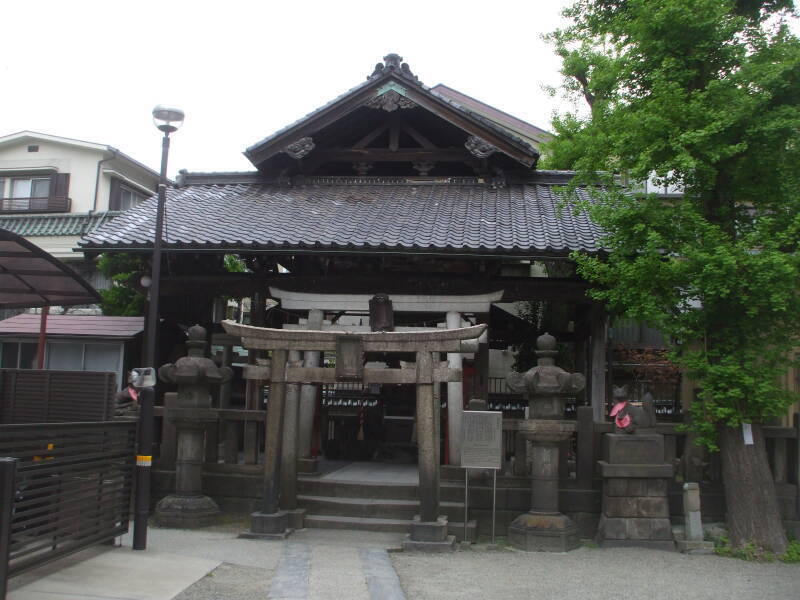
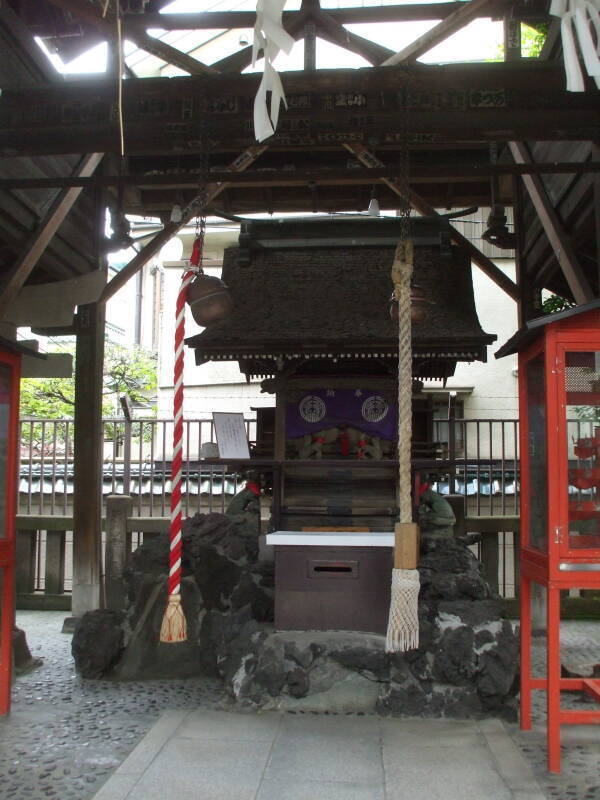

World War II Damage
Tōkyō was heavily damaged by U.S. bombing raids in the last ten months of World War II. One of these raids was the most deadly and destructive bombing raid ever.
A tree near the chōzuya or temizuya, the shelter with the the water reservoir or chōzubachi, was damaged in one of the bombing raids, but it survived.
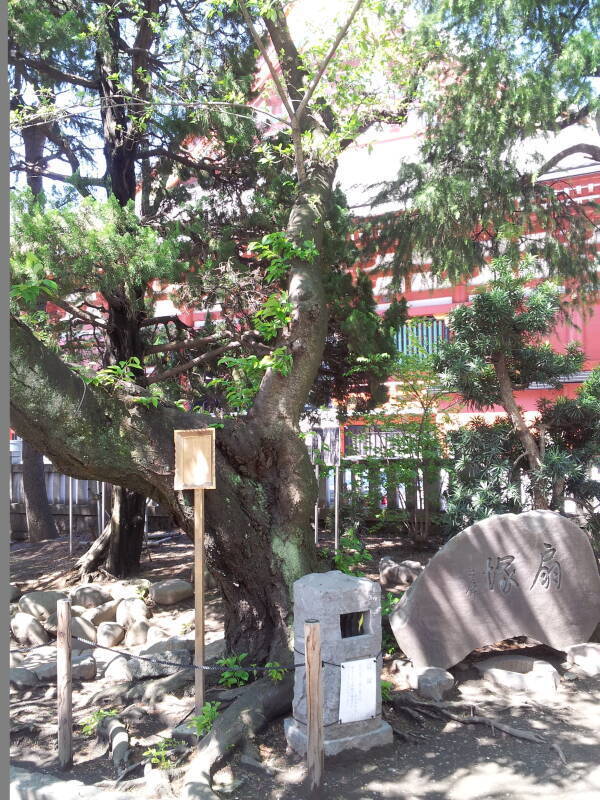
The B-29 Superfortress strategic bomber could carry a heavy load of bombs and drop them from above 30,000 feet, where enemy defenses were very weak. Almost 90% of the bombs dropped on the home islands of Japan were delivered by B-29 aircraft.
The problem was getting the B-29 to the target. While it had an operational range of 3,250 nautical miles, the U.S. didn't have any bases within range. The U.S. Twentieth Air Force operated out of some airfields in southern China, near Guilen, but they could only reach the southernmost island of Kyūshū.
In November 1944 the U.S. had taken the northern Mariana Islands and built airfields on Saipan and Tinian. XXI Bomber Command B-29s launched from there could reach Tōkyō.
Meanwhile the U.S. Army Air Force had been running bombing trials on the Dugway Proving Ground in Utah. High-altitude precision bombing with high explosives was expected to be ineffective against specific industrial targets. General Curtis LeMay ordered the missions to use incendiary bombs.
Industrial sites and residential areas were mixed together in Tōkyō. The non-industrial buildings were mostly built of wood and paper. Incendiary bombing across a general area would create large-scale fires that would destroy the industrial sites, kill much of the working population, and terrorize the rest.
The bombing raids were carried out at relatively low altitudes of 5,000 to 9,000 feet and at night. The Japanese anti-aircraft artillery defenses were weakest at that range of altitudes, and the artillery spotting and defensive fighter aircraft were ineffective at night. LeMay had all the defensive guns removed from the B-29s except for the tail gun, in order to maximize the bomb load.
Operation Meetinghouse
Operation Meetinghouse was an incendiary bombing raid on Tōkyō on the night of 9-10 March, 1945. 334 B-29s took off, and 279 of them reached Tōkyō and dropped 1,665 tons of bombs.
Some of the bombs were M-47 incendiary bombs. Each of them carried 100 pounds of napalm (jelled gasoline) and white phosphorus, and ignited on impact.
The majority of the bombs were the 500-pound E-46 cluster bomb, which had fins to make it aimable. Each of these released 38 M-69 incendiary bomblets at an altitude of 2,000 to 2,500 feet. Each M-69 bomblet was a hexagonal steel tube 3 inches in diameter and 20 inches long, weighing about 6 pounds. On release from the main bomb it released a 3-foot cotton streamer to orient it fuse-downward.
The M-69 would either punch through thin roofing material or strike the ground. 3 to 5 seconds later the fuse ignited a white phosphorus charge that propelled the napalm out to a 100-foot radius.
One B-29 could carry 40 E-46 cluster bombs, for a total of 1,520 M-69 bomblets.
The incendiary raids started in February 1945 against Kobe. In early March they extended to Tōkyō, Nagoya, and Osaka.
In the Operation Meetinghouse raid of 9-10 March, 226 of the attacking aircraft dropped their bombs within the initial two hour period. The first aircraft aimed their bombs to form a large "X" pattern centered on the densely populated working-class area near the docks in the Koto and Chuo city wards. The later aircraft simply aimed for the giant burning "X".
A total of 279 of the 339 B-29s reached the target. 27 of those were lost due to Japanese air defenses, mechanical failures, or loss of control in the updrafts of the massive fires.
The one raid destroyed an area of about 16 square miles of the city, killed about 100,000 people, injured about a million people, and left a million people homeless.
What the U.S. designated "Zone 1" included Asakusa, Honjo, and Fukugawa Wards. Asakusa Ward was the most populous of the 35 wards making up greater Tokyo. With 135,000 inhabitants per square mile, it was one of the most densely populated areas in the world. Many of the dwellings incorporated workshops, with the residents manufacturing parts for assembly at large defense plants. Honjo and Fukugawa Wards, across the Sumida River, had population densities of 80,000 to 135,000 people per square mile. In all, and 1.1 million people, 15 percent of Tokyo's population, lived and worked in Zone 1. The 9-10 March raid almost completely destroyed that area, along with Joto and Shitaya Wards.
This was the single deadliest air raid of World War II, completely destroying a larger area than the incendiary raids on Dresden and Hamburg, and larger than the atomic bombings of Hiroshima and Nagasaki, combined.
Next: Mitsumine Shrine » Or your choice:
The above is specific to Asakusa in Tōkyō. Or maybe you want to explore other places in Japan.
Other topics in Japan:




































